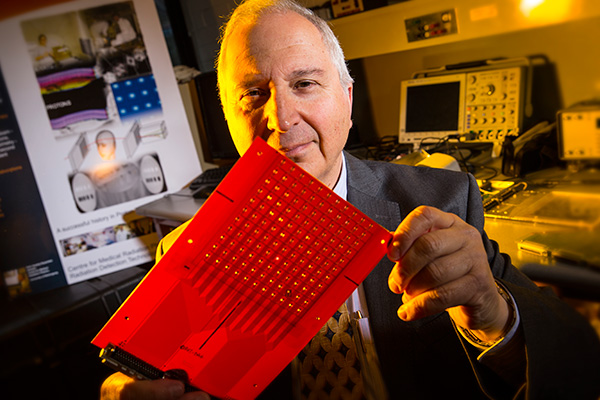August 22, 2014
Japan partnership spreads rays of life for cancer treatment to Australia
An agreement between UOW and the prestigious Japanese National Institute of Radiological Sciences (NIRS) will allow Australian researchers access to cutting-edge cancer therapy that is currently not available in Australia.

A Memorandum of Understanding (MoU) was recently signed between NIRS and UOW, through Professor Anatoly Rozenfeld (pictured), Director of the Centre for Medical Radiation Physics (CMRP) that will allow the two institutes to share research, training, facilities and researcher exchanges.
The NIRS, in Chiba, Japan, is a leading research institution that is developing radiation therapy for cancer treatment, particularly in the promising field of heavy ion therapy.
Heavy ion therapy for cancer involves directing beams of particles called ions at cancer cells. The ions can be precisely targeted to the location and size of the tumour, limiting damage to surrounding healthy tissue.
Similar to proton therapy, carbon ions can be stopped at any required depth in a body, sparing normal tissue in front of the tumour and delivering almost zero radiation downstream of the tumour. Such precision is not possible with other radiation treatments such as x-ray therapy.
In addition to precision, ion therapy also packs a punch - it has what is known as a high radiobiological efficiency, up to three times that of x-ray treatment. The result is that a smaller dose of radiation is needed to eliminate target cells.
Professor Rozenfeld said this treatment could be hugely beneficial for many types of cancers and particularly for children who would otherwise require high-risk surgery if the tumour is located near the spinal cord or in the brain.
“When the child has a brain tumour or a blastoma we have to be careful to avoid irradiating critical organs. With x-ray therapy this is very difficult and sometimes almost impossible to do. With heavy ion therapy we can ensure the tumour is identified with precision imaging and irradiated accurately without harming surrounding tissue.”
Heavy ion therapy is not currently available in Australia but through the MoU, the first Australian agreement to develop experience in heavy ion therapy, Professor Rozenfeld’s team will have access to the treatment centre in Japan.
Professor Rozenfeld will assist the NIRS with expertise in custom-designed instrumentation to measure radiation dose and radiobiological efficiency of the carbon ion beam. The instrument uses silicon-based microdosimetry and was last year awarded a US patent for the invention.
Professor Rozenfeld, who has dedicated his life to finding better treatments for cancer after losing both parents to the disease, said the CMRP detector technology would be used to assist Japanese researchers further develop heavy ion therapies for cancer treatment.
He said he hoped the collaboration with NIRS in Japan would help prepare a case for Australia’s first national heavy ion therapy centre.
“This collaboration brings years of experience in heavy ion therapy to Australia, particularly in a field of medical radiation physics and training of new generation of medical physicists with skills required for future Australian heavy ion therapy,” he said.
The first 10 medical physics students and two academics from the CMRP will take part in training in Japan in September, which is supported by Australian Government Short-term Mobility Program successful grant and NIRS.
In November this year, Dr Susanna Guatelli from CMRP will visit several heavy ion therapy centres in Japan to establish scientific collaboration that is supported by grant from Australian Academy of Technological Science and Engineering (ATSE) and Japan Society for the Promotion of Science (JSPS).